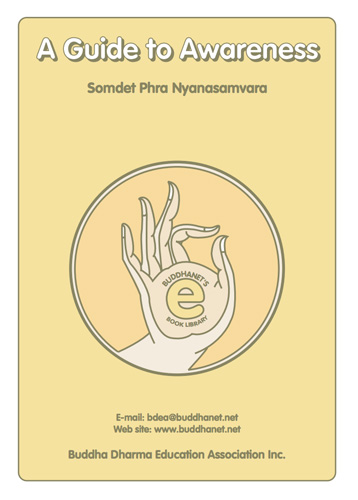 Image search results - "satipatthana sutta" Image search results - "satipatthana sutta" |

03_Framework-for-practice.mp3(3) Framework for the Practice3019 viewsThe Framework for the Practice is based on the Four Establishments of Mindfulness (Satipatthana Sutta): Body, Feelings, Mind States, and Mind Objects.
|
|

05_satipatthana_sutta_01.pdf01 Satipatthana Sutta3241 viewsWe have seen how different approaches to translation provide different approaches to the meditation practice itself. Translation, interpretation and practice all take place within communities. One's choices in translation is also an expression of one's identity. If I identify with a specific tradition, I will translate in a way that fits with that tradition's view of the teaching and the practice. If I refuse to identify with a tradition, preferring to go my own way or be part of the creation of a new tradition, this choice also will condition translation and interpretation. And interpretation conditions practice. The practice is defined by its texts, and the texts are formed by translation and interpretation.
|
|

06_satipatthana_sutta_02.pdf02 Satipatthana Sutta2562 viewsDuring this course we have looked at how different interpretative communities read the Nikayas. Among these are contemporary communities formed by the experience of modernity, practitioners who are attempting to apply the teachings found in the Nikayas to their daily lives in the contemporary world. Locating ourselves within such a community, we can see that our reading is a form of practitioner criticism. We have sought to make sense of this alien literature firstly by acknowledging that it is not a literature at all, but a collection of oral performances. We have examined how these performances are both made up of and linked by patterns of repetition lists of lists within lists. The lists function like tables in individual databases, and the teaching as a whole - the dhamma - functions as a relational database which exists, not within any given sutta, but as a network of relationships which underlies and unites all the suttas.
|
|

frames_ref.pdfFrames of Reference4307 viewsThis book on the frames of reference is based to some extent on my own thoughts and opinions. In some spots it may not be directly in line with the original text (Satipatthana Sutta), because my primary aim has been to get to the heart of the matter, so that it can be conveniently put into practice. The eBook also includes a section on the Duties of the Sangha, that is, the laws and regulations and disciplinary standards (Vinaya).
|
|

gawarens.pdfA Guide to Awareness5471 viewsThe Foundations of Mindfulness (Satipatthana Sutta). This is a series of twenty-two talks given at Wat Bovornives, Bangkok by H.H.Somdet Phra Sanasamvara, Supreme Patriarch of Thailand. The Four Foundations of Mindfulness is the Buddha's explanation of the practice of mindfulness meditation within the framework of four foundations of awareness: body, feelings, mind-states and the mental content. If you read this book, you will discover the truth of the 'knots' and problems that exist within you. In short, this can be described as the 'knot of suffering'. You may also then see the method to unravel and safeguard against this suffering.
|
|

mahasati.pdfMaha Satipatthana Sutta3311 viewsVen. U Jotika and Ven. U Dhamminda
Practise in accordance with this Mahasatipatthana Sutta so that you can see why it is acknowledged as the most important Sutta that the Buddha taught. Try to practise all the different sections from time to time as they are all useful, but in the beginning start with something simple such as being mindful while walking, or the mindfulness of in and out breathing. Then as you practise these you will be able to practise the other sections contained within this Sutta and you will find that all the four satipatthanas can be practised concurrently. A Sutta should be read again and again as you will tend to forget its message. The message here in this Sutta is that you should be mindful of whatever is occurring in the body and mind, whether it be good or bad, and thus you will become aware that all conditioned phenomena are impermanent, unsatisfactory and not self.
|
|
|
|
